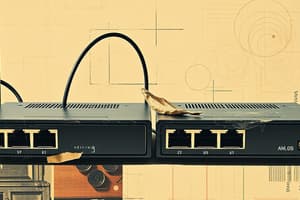Podcast
Questions and Answers
What is the main function of a network switch?
What is the main function of a network switch?
- Extending wireless coverage
- Sharing bandwidth among all ports
- Filtering and forwarding data (correct)
- Reproducing signals
How does a switch differ from a hub?
How does a switch differ from a hub?
- A switch allocates bandwidth for each port. (correct)
- A switch forwards data to an IP address.
- A switch is used for data transferring.
- A switch shares bandwidth among all its ports.
Which device acts as a portal for devices to connect to a local area network wirelessly?
Which device acts as a portal for devices to connect to a local area network wirelessly?
- Hub
- Repeater
- Access Point (correct)
- Bridge
What is a disadvantage of wireless access points?
What is a disadvantage of wireless access points?
How does a switch handle the flow of signals?
How does a switch handle the flow of signals?
Which device is used for data transferring in networking?
Which device is used for data transferring in networking?
What separates the functionality of a switch and a hub?
What separates the functionality of a switch and a hub?
Which wireless network device combines a transmitter and receiver to form a WLAN?
Which wireless network device combines a transmitter and receiver to form a WLAN?
Study Notes
Network Hubs
- Hubs do not significantly impact network performance, but have notable disadvantages including:
- Inability to filter information efficiently.
- Lack of ability to reduce network traffic.
- Data is broadcasted to all ports.
Types of Network Hubs
-
Active Hub:
- Equipped with its own power supply.
- Cleans, amplifies, and transmits signals, acting as a wiring center and repeater.
- Essential for extending distances between nodes.
-
Passive Hub:
- Does not have a power supply; simply collects wiring.
- Transmits signals without enhancement or cleaning, unsuitable for long-distance connections.
Repeaters
- Function to reproduce incoming signals before they weaken or become damaged.
- Repeater does not amplify signals but reproduces them at their original strength.
- Operates as a two-port device, with one port for incoming and another for outgoing signals.
- Effective in environments like office buildings and schools where single routers can't cover the area.
Bridges
- Bridges connect multiple network segments, storing and transmitting frames between them.
- Allow connection of two physical local area networks into a wider logical network.
- Bridges reduce data collisions and traffic through minor segmentation.
- Types of Bridges:
- Transparent Bridge: Connects LANs using the same protocols.
- Translation Bridge: Joins LANs with different protocols.
- Maintain a MAC address lookup table to determine whether to forward or discard frames.
Advantages and Disadvantages of Bridges
-
Advantages:
- Minimize data collisions.
- Decrease network traffic through segmentation.
- Can connect different types of networks with varying cabling.
-
Disadvantages:
- Typically more expensive than repeaters.
- Slower operation compared to repeaters due to the filtering process involved.
Routers
- Routers are devices that receive, analyze, and forward incoming packets to targeted networks.
- They determine the target IP address for packets and route them accordingly.
- Utilize a routing table to identify the quickest and most efficient paths for packet delivery.
- Routing tables can be of various types, aiding in effective network traffic management.
Studying That Suits You
Use AI to generate personalized quizzes and flashcards to suit your learning preferences.
Description
Explore the disadvantages of network hubs, including the inability to filter information and reduce network traffic. Learn about the classification of network hubs into active hubs, which have their own power supply and serve as signal repeaters.




